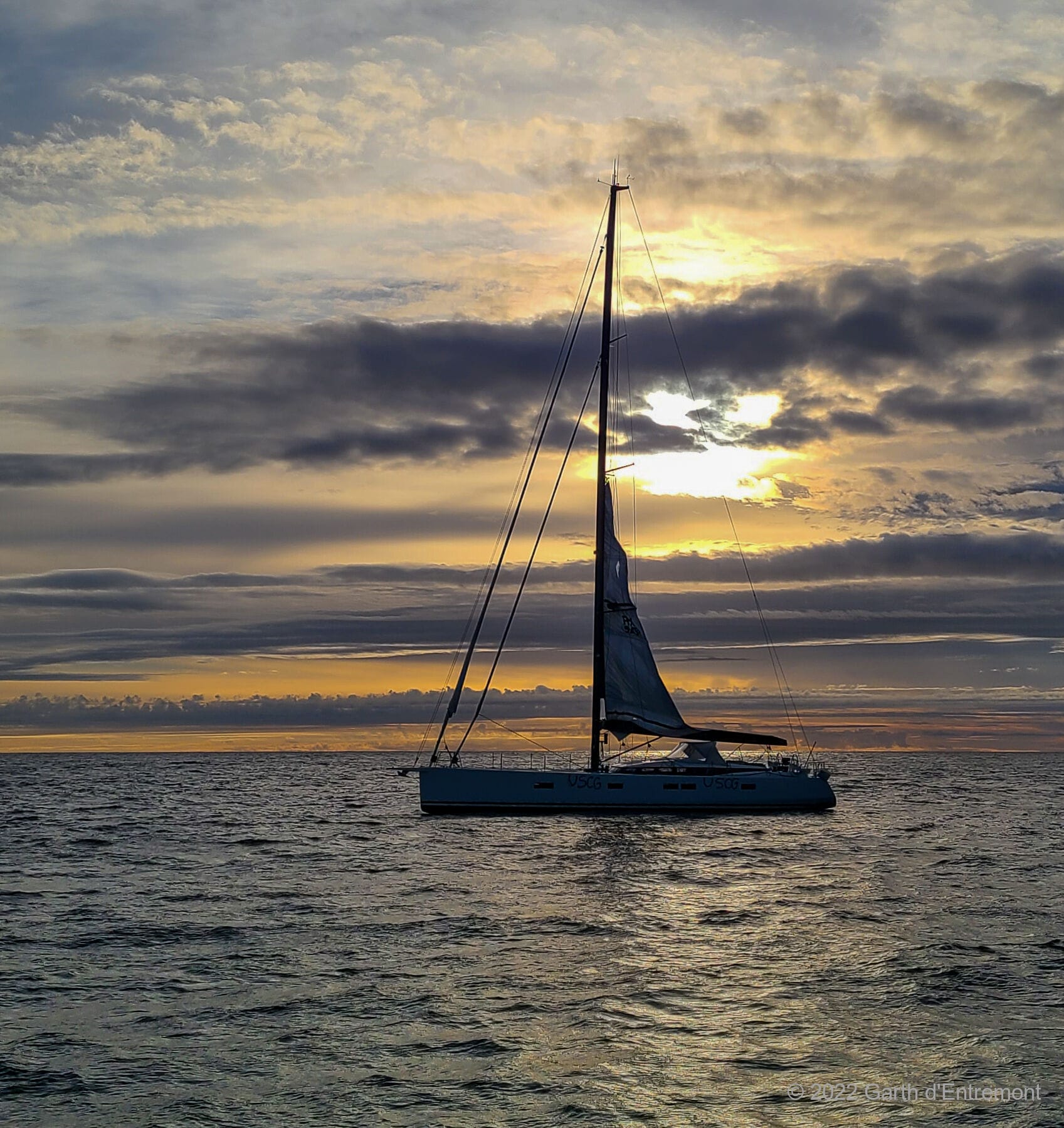
While I was researching for my article about the tragedy south of Nova Scotia in which Volker-Karl Frank and Annamarie Auer-Frank were fatally injured on the CNB 66 Escape, I interviewed the salvage master, Phil Wash.
At the request of the insurance company, Phil went out with a team on a fishing boat out of Pubnico, Nova Scotia, found the abandoned boat, secured the mainsail and boom, got the systems going again, and brought her back to Halifax under her own power supplemented by the headsails.
The Team
Crew that boarded S/V Escape and brought her safely into Halifax:
- Phil Wash
- Mike Coady
- Les Savage
Crew of F/V Life Sentence out of Pubnico, Nova Scotia:
- Bob Hines, owner
- Gordon Moulaison
- Garth D’Entrement
I also spoke with Gordon and Garth, and Garth kindly provided the photos.
The Real Hard Men
Gordon and Bob fish off Cape Sable, Nova Scotia, some of the most challenging waters anywhere in the world, in a lobster season that runs from late November to the end of May—you read that right, winter North Atlantic.
Gordon then takes the boat to go after other species in the summer, ranging from the Grand Banks south to the Gulf Stream.
Garth is the chief mate on a trawler that fishes for shrimp from Hudson Strait to Greenland, for as much of the year as the ice will let them…and sometimes past that—Garth’s trawler got damaged by ice last year and needed extensive repair. (Garth was not aboard on that trip.)
Finding Escape
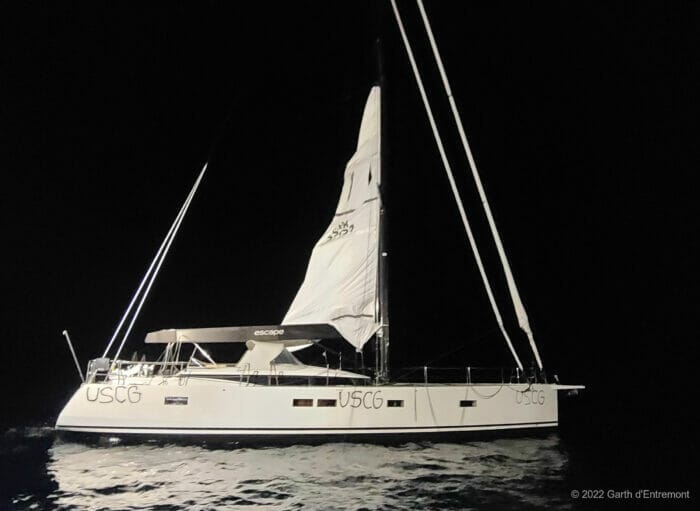
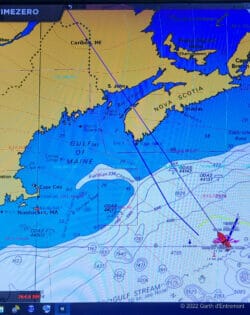
To figure out where Escape might have ended up, Gordon used his experience of fishing the edges of the Gulf Stream with drift gear to augment the drift predictions they were getting from other sources.
After four days of searching, Gordon was on watch in the middle of the night and got a weak radar target at 14 miles and altered course toward it. The target did not firm up until four miles.
Once again, Gordon’s experience played a part because he knew that there was no fishing gear in that area, even though the weak target looked like exactly that and others might have passed it by.
And there Escape was, 83 nautical miles from her last known position.
Boarding Escape
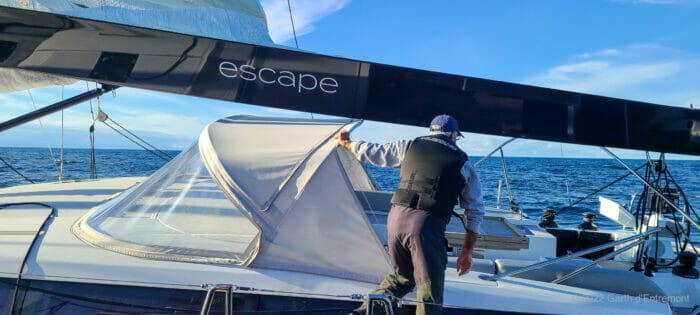
Phil boarded in the morning, deeply apprehensive because at that point he had not been briefed on the tragedy and so had no idea what he would find. A murder scene? A boat stuffed with drugs fought over by rival cartels?
The State of The Boat
Phil shared the state of Escape when they got aboard:
- The main boom was resting on the dodger and the remnants of the bimini.
- The main halyard had been cut, or possibly broken, just above the constrictor clutch that secured it.
- The mainsail was partially roller reefed but the luff had tracked forward in the process and jammed the mechanism.
- Quite a lot of the remaining mainsail was still partially hoisted.
After comparing what the salvage crew found to the account in Blue Water Sailing, Phil and I surmise that:
- The jam in the in-boom roller reefing occurred after Karl and Annamarie where injured, as the remaining two crew tried to get the mainsail down—confirmed by the report.
- In-boom roller furlers take very precise handling, by someone experienced with that particular installation, in order to furl without jamming, particularly in gale force conditions.
- The halyard was cut by the surviving crew, maybe because they could not get the clutch to release.
- That type of constrictor clutch securing the halyard—think Chinese finger trap—is known for being difficult to operate by those unfamiliar with them.
Phil also found a lot of Clipper Race crew gear aboard, indicating that Karl and/or Annamarie had done one or more legs of that gruelling race.
Bringing Her In
Once Phil had assessed the situation aboard Escape, Les and Mike boarded and the team got the rig stabilized, and then figured out how to get the systems up and running and the engine started. Not an easy task since everything was labeled in German and Escape is a very complicated boat.
They then unfurled the headsails and headed for Halifax harbour, where they arrived a couple of days later, exhausted but justifiably elated at what they had accomplished.
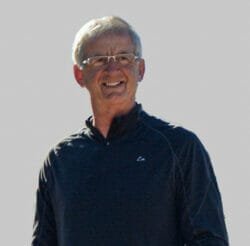
This was an amazing achievement that only a mariner and boat technician of Phil’s caliber and experience, assisted by other experienced sailors, could have pulled off.
Phil is the person that every boat owner in his wide circle of friends, including me, calls when we have a problem that no one else can figure out how to fix, or a tough ocean passage to do.
Just one example of how resourceful Phil is: A couple of years ago when the drive pulley on his J/120 engine freshwater pump broke late one afternoon at the start of a club cruise, Phil hitched a ride home, found a lump of aluminum, machined a new one in his fully equipped home shop, napped for a couple of hours, hitched a ride back to the boat, and had the engine running the following morning so as to meet the rest of us at the next anchorage that afternoon.
As I often say, if McMaster-Carr doesn’t have the bits we need, and/or Phil Wash can’t fix it, we are truly and utterly screwed.
Done and Dusted
Sure, the team was assisted by a good run of settled weather, but none the less, if you want to head out 250 miles into the North Atlantic and search for a needle in a haystack—Escape was not transmitting any position information—Bob, Gordon and Garth are the guys you need.
And then Phil, Mike and Les delivered the boat back to Halifax without the risks of towing, and without drama or fuss. Not easy either. It’s hard for those who have not spent time at sea to understand the difficulty of getting unfamiliar and complex systems up and running, particularly as a boat rolls in leftover swell.
Further Reading
- My analysis of the the tragedy with recommendations (free to read).
- I have written about the fishers of Southwestern Nova Scotia before in The Real Hard Men (free).
- Lessons from other disasters at sea (some articles are free).

The CNB 66 with a 100 foot complex mast was the wrong boat for that unfortunate couple intending to make a world cruise. Maybe the right boat for racing or charter, Med or Caribbean.
Hi Manuel,
I wrote about boat suitability and accident causes here: https://www.morganscloud.com/2022/08/22/lessons-from-a-tragedy-at-sea/
Hi John, I fully agree with your vision about boat suitability. Notwithstanding that unfortunate couple did not have much thought and time about the kind of boat on witch they could accomplish their around the world dream. Am I wrong?
Hi Manuel,
I was not suggesting that you were wrong, just that it was better to discuss that sort of thing on my article about the causes, rather than this one about the salvage.
Hi John and all,
Good story and an impressing salvage.
For those who appreciate these types of reports, Farley Mowat, in his book, Grey Seas Under (from memory) took the logs of the salvage tugs out of Halifax from WWII era and wove them into their stories and wrote one of the best books I have ever read. It reads like an adventure novel. Truly astounding feats and these have life and death consequences and range over much of the North Atlantic in winter.
My best, Dick Stevenson, s/v Alchemy
Thanks John. I know two of the salvage crew personally, Phil and Les, and can only reinforce that they are the sort of folk you would want at your side in any tight situation. I have no doubt that the others are made of the same material.
I went down the Further Reading rathole to your 2014 post about lessons learned from two yacht losses at sea: Easy Go and Be Good Two.
https://www.morganscloud.com/2014/01/18/two-yacht-losses-many-lessons-learned/
That post and its many excellent and far-ranging comments are well worth re-reading.
Wilson
Hi Wilson,
Thanks for the kind words and endorsement of that post.
Hi John,
Thanks for the account. Finding a boat like that must be unbelievably hard. Some of my favorite books to read have been about marine salvage and finding big ships is incredibly hard, a small vessel like this would be far harder. I used to think that if I were not single and didn’t mind long periods of no sleep that it would have been great to work for someone like Smit, Svitzer or Titan when I got out of school for a few years. To make it in salvage, you have to be good at just getting it done.
Eric
Great observation Eric- and in fact there was an awful lot of work that went on ashore before and during the recovery effort that ultimately facilitated the timely recovery of the vessel.
Let me be clear – this is not to take away from the incredible seamanship and efforts of both the fishing crew and the recovery crew. They all performed superbly.
I know about the background efforts, because I was the fellow that pulled this group together – at the request of Leeway Marine, who were engaged by the insurance co. Leeway’s available vessel was down with- of all things – a sheared raw water pump shaft, and was not able to respond. They reached out to me to see if I could pull together a crew and lead the recovery effort, since they were unfamiliar with the details and subtlety of a large sailing vessel. I very nearly left on my own boat to go and find it (I was almost complete preparations to head to Bermuda but was unable to leave my business at the time. Turns out that was a good thing!
My first call was to Phil, who I knew was the right man for getting on the boat and bringing it in safely. My second call was to Alain D’Entremont, a leader in the massive SW Nova Fishery. I knew Alain would pull the right boat with the right crew from the options he had. My third call was to a client of my engineering company called Carte Nav, who develop integrated SAR consoles and software. Their systems are used on SAR and border/sovereignty patrol aircraft around the world, and are incredible suites of combined radar/lidar/infrared/AIS/weather and GIS overlays.
CarteNav put me in touch with the fine folks at PAL (Provincial Airlines) who do much of the sovereignty, whale counting, fisheries and ice patrols off the east coast of Canada. Their operations man -Jens – is a sailor, and was very sympathetic to the issues. he left a family vacation in western Newfoundland to get to a hill where he had cell service, to see if he could find us a plane and a crew to run a search pattern.
While Jens and I were working on getting some air support, Leeway were working on convincing the Insurance Co that they should spend the many tens of thousands on the potential air support, and trying to persuade the US Coast Guard to give them updated SAR drift maps and predictive patterns for the drift path of the vessel. The USCG was obviously the hero in the initial recovery of the crew, as is their mandate – but their interest in supporting recovery fo commercial assets afterwards is understandably limited.
All this time, the boat crew were offshore, running their own search patterns based on their experience with drifting gear and the (now well outdated) original USCG drift charts.
After a few days of fruitless searching, the Insurance co agreed to the air search, and Jens juggled their flight schedules and called for volunteers at PAL to run a search for this tragic event. Their entire training leadership- including chief pilots, chief SAR systems trainers and lead operators all volunteered, and went home early to be able to leave for the search at 3am, from St John’s airport. they reserved their main patrol aircraft- a fully customized Dash 8 loaded with CarteNav equipment and fuelled up for an 8 hour surface search. This plane runs nearly 24/7 at this time of year on patrol – it was incredible that he could free it up.
Jens also twisted the arm of the ice drift mapping team there, and got them to develop a full drift pattern chart based on their met and current data, going back over a week to the point of abandonment. He then shared a search pattern start point with me, which I got to Alain (who was in touch with the boat via Iridium Go) and to Phil (whom I was in touch with thru a Globalstar handset).
I gave them that waypoint and they headed there at about 5pm on the evening before the plane was to be at the waypoint and starting it’s search. It was around 80 NM from their position at that time.
I was woken up by an ecstatic Phil on the phone at 3am that morning – ‘We’ve got a boat!’. They had made it almost to that waypoint- and it was close enough that his radar and experience allowed Gordon to make the identification and close the gap.
I immediately called the PAL dispatch at St. John’s and let them know – but the plane was in the air… Hilarious conversation with a very lively Newfoundlander at 3am (if you’ve ever been to Newf you know what I mean – ‘now way, bye! they found da boat? right on- good on ya byes! ok, no prob my fine feller, I’ll call dat plane right back now!’…)
They had to circle for a few hours to burn up fuel before they could land again, but were happy to have their mission cut short with a successful find.
The rest is well outlined above – indeed I learned a few things here!
Again – I want to be clear- this was the dream team of crews headed out to do the recovery of this vessel, and they did it superbly. No amount of shore support will bring anything home without the guys who get out there and do it – and do it well.
It was very fulfilling to be able to contribute to the success of the event from shoreside – even if I was 100% wishing I was offshore with them the whole time!
As a post-script to this story, Phil and crew just delivered Escape to Portland Yacht Services, Maine, and the Nova Scotia portion of this sad tale is now concluded.
Hi Ren,
Thanks so much for the fill on that. I knew you had been involved in putting the salvage together, but had no idea of the back story, fascinating!